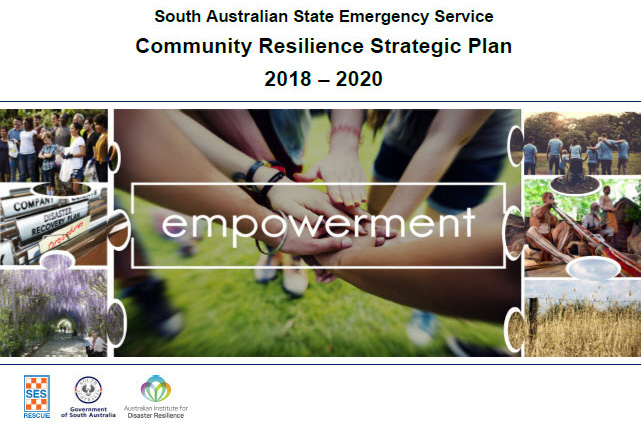Developing a community resilience plan entailed understanding what communities need and how emergency management services can build resilience. These needs don’t always match.
The AIDR Resilience Ambassadors Program upskills young people to become champions of resilience in their organisations and regions. As part of the program, I worked with colleagues to develop a Community Resilience Strategic Plan for the South Australian State Emergency Service (SA SES).
In 2017, the SA SES was already delivering and contributing to a range of community engagement and resilience-building initiatives. What was missing was a framework to align these activities to organisational objectives. The Community Resilience Strategic Plan provided the strategic direction, objectives and goals necessary to benchmark and evaluate success. Undertaking this project developed my understanding of what a community needs to be resilient and how an emergency services organisation could support that resilience. The needs of agencies and communities don’t always match. Priorities, timelines and even the language used to describe resilience-building are often disparate.
What does a resilient community look like?
In the book, The Resilience Dividend, Dr Judith Rodin writes:
"There is no ultimate or end state of resilience. But, by working together to build resilience to the greatest degree possible, we can reduce our reliance on crisis as a driver of change and, instead, deliberately take the future into our own hands – for the well-being of our families, our communities, our cities, and indeed, the planet we share."
These questions guided the thinking on the vision of what resilience is. If there is no end state to resilience,
how can we develop a community enough in order to achieve resilience? What behavioural, procedural or
environmental changes are needed to improve or achieve resilience?
One size does not fit all
The community is the centre of a Community Resilience Strategic Plan and objectives are tailored to community needs. The needs of the community and the strengths and assets that contribute to a community being resilient need to be researched and documented. Consultation is essential and this should be conducted internally and externally with other organisations and the community you are developing the plan for.
Change takes time
The strategy, objectives and goals need to be achievable with observable benchmarks for success. The challenge with some initiatives that foster community resilience is that they are reliant on behavioural change in order to show success. This could span many years, beyond the time period the plan covers. Planning requires interim benchmarks that provide a pathway to change and success.
Realistic influence
There are many elements that contribute to a community developing its resilience. Organisations may
not have the capacity or authority to achieve some objectives and not all problems can be solved. In order
to foster resilience, creating partnerships with changemakers and other organisations may be needed to
advance support for communities. This contributes to a ‘shared responsibility’ that brings government agencies, non-government organisations, communities and those who have influence to make change together to build resilient communities.



